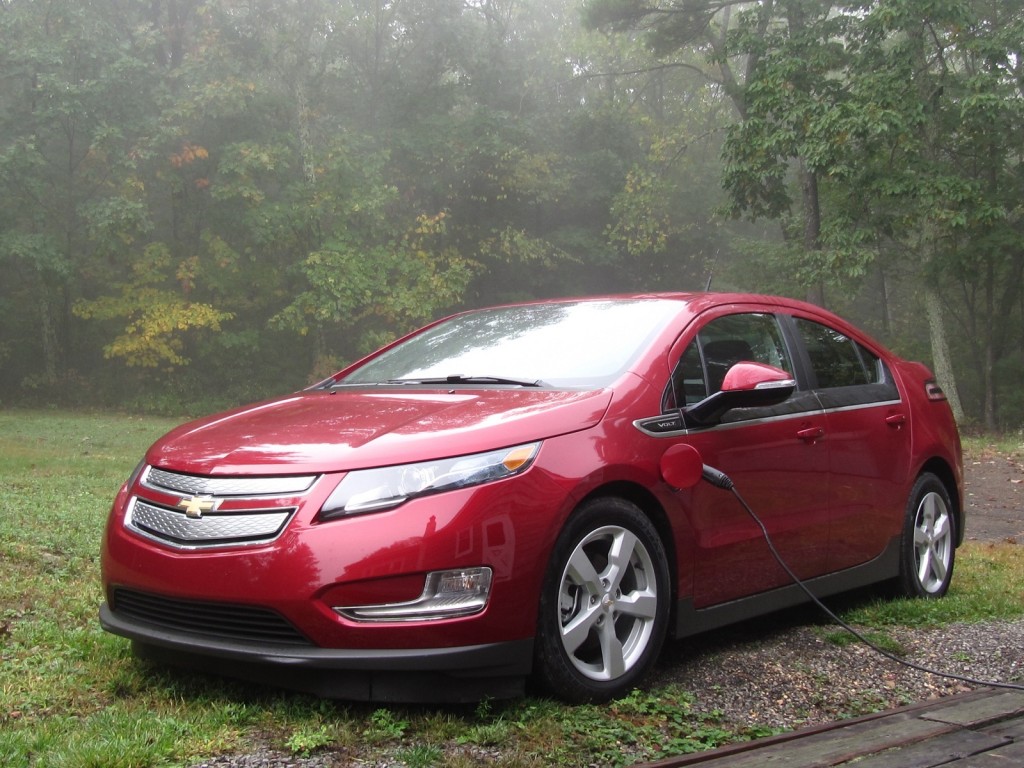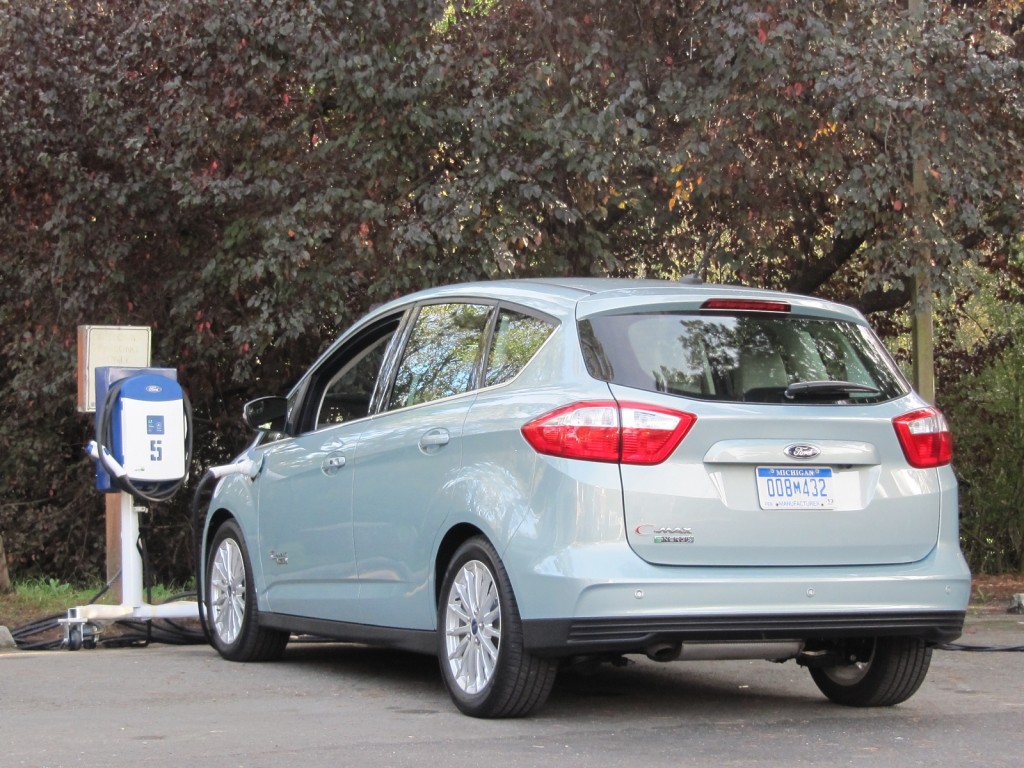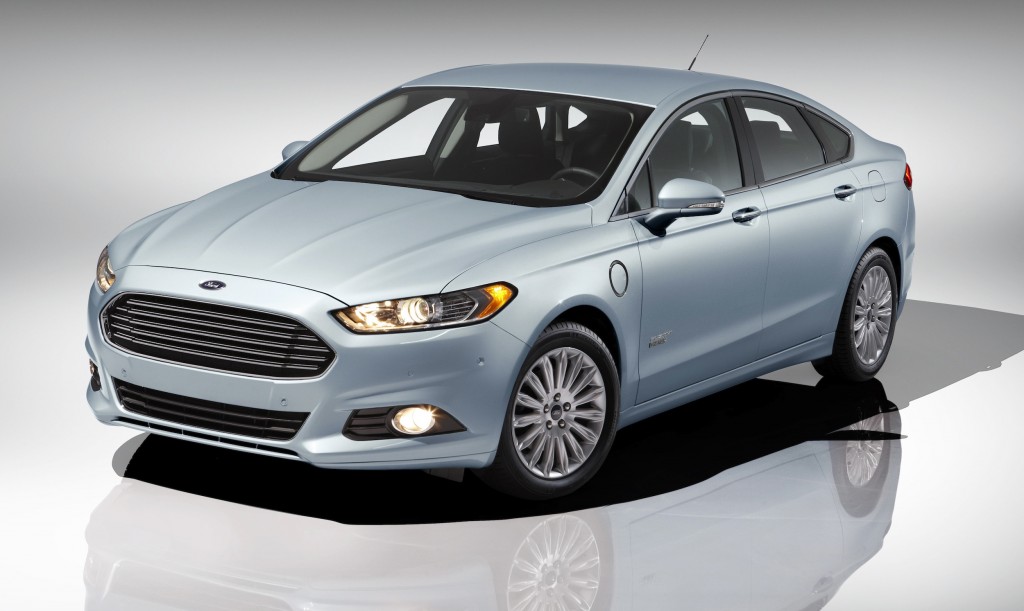Not all plug-in electric cars rely on battery power alone; some also have gasoline engines as backups, for longer range or more power.
Last year, we identified six plug-in hybrid vehicles on sale during 2013.
This year, the list gains three new entries (from BMW, Cadillac, and Mitsubishi) and loses one (the Fisker Karma).
Note that we're lumping into this category cars with two different types of drivetrains.
First are the plug-in versions of conventional hybrids, including the Ford's C-Max Energi and Fusion Energi models, the Honda Accord Plug-In Hybrid, and the Toyota Prius Plug-In Hybrid.
Then there are the range-extended electric vehicles, in which only electricity powers the wheels and the engine runs a generator that produces electricity for that purpose.
Those cars include the upcoming BMW i3 ReX, the Chevy Volt, its platform twin the Cadillac ELR, and the now-departed Fisker Karma.
Then there's the Mitsubishi Outlander Plug-In Hybrid, which can work either way. (The Accord Plug-In Hybrid can act either way too, but it's adapted from a conventional hybrid).
With that little bit of education out of the way, here's our list of plug-in hybrids that will be on sale in the U.S. for the 2014 model year.

2014 BMW i3 concept live photos, 2011 Frankfurt Auto Show
2014 BMW i3 ReX
New to the market early next year will be BMW's first plug-in electric car, an all-new dedicated vehicle that comes as a battery-electric vehicle or with a small two-cylinder range-extending engine.
The car's 21- or 22-kWh lithium-ion battery pack sits in an aluminum chassis structure, with a carbon-fiber reinforced plastic body shell on top. The shell is so strong that BMW can dispense with center door pillars altogether: the rear doors are rear-hinged, meaning the entire side of the car opens up for unparalleled ease of access.
A 125-kW (168 -hp) electric motor powers the rear wheels, but the "ReX" range-extended version uses a small two-cylinder engine and generator that also tucks under the rear deck.
That engine, along with a 2- or 3-gallon gas tank up front, will give the BMW i3 ReX almost double the battery range of 80 to 100 miles (figures haven't yet been released).
But, unlike the Chevy Volt and Cadillac ELR, performance in range-extending mode may not match that delivered by the battery pack.
BMW points out that the range extender is not meant for everyday use, but more for occasional and emergency situations.
The first BMW i3s are likely to arrive at dealers shortly after January 1, at a price similar to that of a well-equipped 3-Series, or perhaps $42,000 to $46,000.
The ReX range extender, however, will likely cost a few thousand dollars more on top of that.

2014 Cadillac ELR revealed at 2013 Detroit Auto Show
2014 Cadillac ELR
The striking Cadillac ELR range-extended electric coupe has had a checkered history, with production approved and then canceled during the days of GM's 2009 bankruptcy.
Widely lauded for its striking lines, the production version of the ELR goes on sale later this year in a form remarkably close to the concept car shown in 2009.
It shares the Voltec range-extended powertrain of the Chevy Volt, including a 16-kWh lithium-ion battery pack housed in the tunnel and under the rear seat, and a 1.4-liter range-extending four-cylinder engine up front.
But the ELR is expected to have quite different electronic control software, giving it a different feel and most likely more performance to offset the weight of its many luxury features.
GM hasn't released final power, performance, range, or fuel-efficiency ratings for the 2014 ELR, nor has it said anything about its price.
That information will likely arrive this fall.

2013 Chevrolet Volt, Catskill Mountains, Oct 2012
2014 Chevrolet Volt
The Chevy Volt will continue in its fourth model year with just a handful of changes, though it will be joined on the assembly line by the Cadillac ELR range-extended electric coupe that shares its Voltec powertrain.
The five-door four-seat compact hatchback is rated at 38 miles of electric range, after which its 1.4-liter gasoline range extender kicks on to generate electricity to power the car another 300 or so miles.
Under certain limited circumstances, the engine can be mechanically clutched into the drive unit to supplement the electric power. The driver will never know when this happens, however, and the Volt driving experience remains electric in feel: smooth, quiet, and without any gear shifting.
For 2012, the Volt was the best-selling plug-in electric car in the U.S. For the first four months of 2013, it was likely slightly outsold by the Tesla Model S.
2014 Ford C-Max Energi

2013 Ford C-Max Energi plug-in hybrid, Marin County, CA, Nov 2012
The Ford C-Max Energi plug-in hybrid enters its second year, which provides an electric range of 21 miles and then reverts to being a (slightly heavier) version of the conventional hybrid C-Max.
The C-Max Energi will hit 85 mph in all-electric mode, and it will hold in electric-only mode much longer than the plug-in Prius (below) which switches on its engine under anything more than light to medium load.
The plug-in C-Max is one of two Energi models from Ford, both using identical powertrains based on a 2.0-liter four-cylinder engine and Ford's twin motor-generator hybrid system, along with a lithium-ion battery pack in the rear.
One drawback to the Energi version of the C-Max: the larger battery pack mounted under the load deck raises rear deck height significantly, both making for a higher liftover height and cutting into cargo volume.
Pricing starts at $33,745--cheaper than its plug-in Prius rival.
2014 Ford Fusion Energi

2013 Ford Fusion Energi
Like the C-Max Hybrid (above), the Ford Fusion Energi is a plug-in adaptation of the higher-volume Fusion Hybrid.
Both vehicles use a 2.0-liter four-cylinder engine and Ford's hybrid transmission, but the plug-in Fusion sedan provides 21 miles of EPA-rated electric range and an efficiency rating of 100 MPGe. (MPGe stands for Miles Per Gallon equivalent, or the distance that a car can travel electrically on the amount of energy contained in 1 gallon of gasoline.)
The Fusion Energi has the advantage of looking just like a regular Fusion--if you disregard a few trim details and the charging-port door on the left-front fender--for those buyers who don't want their choice of a plug-in vehicle to make them stand out from the crowd.
While the C-Max competes against the Toyota Prius, the Fusion Energi is more likely aimed squarely at the Chevy Volt.
Like its sibling in Ford's plug-in lineup, it can run in all-electric mode at speeds as high as 85 mph under the right circumstances.

2014 Honda Accord Plug-In Hybrid
2014 Honda Accord Plug-In Hybrid
It will be joined later this year by a conventional Accord Hybrid model, but right now, the plug-in Honda Accord is the only car to offer the company's new, twin-motor hybrid system for larger vehicles.
Aimed at both the Ford Fusion Energi and the Toyota Prius Plug-In Hybrid, the Accord Plug-In Hybrid falls between them in electric range--at 13 miles--but offers a remarkable 115 MPGe efficiency rating, far higher than the Fusion Energi's 100 MPGe or the plug-in Prius, at 95 MPGe.
Our first drive of the car revealed a pleasant drive and several useful features, though we'll wait to make our final conclusions until we've driven one over longer distances and in more varied uses.
The 2.0-liter four cylinder drivetrain with two-motor electric assistance can work in all-electric mode, as a series hybrid, or as a parallel hybrid. Its total combined power output from both systems is 196 horsepower.
Honda is slowly ramping up plug-in hybrid sales in California, but the conventional 2014 Accord Hybrid will be sold nationwide when it launches this fall.

Mitsubishi Outlander Plug-In Hybrid, 2012 Paris Motor Show
2014 Mitsubishi Outlander Plug-In Hybrid
The Outlander Plug-In Hybrid isn't the first electric car Mitsubishi has offered in the U.S., but it's aimed at a far larger market segment than its tiny all-electric i-MiEV minicar.
The plug-in family utility vehicle is an ambitious attempt to add 20 or more miles of electric range to a mid-size crossover, which then operates as a hybrid once the 12-kWh battery pack is depleted.
In that case, Parallel Hybrid Mode largely uses the gasoline engine for propulsion, with the electric motors assisting. This mode predominates at higher speeds, when the engine can be run at peak efficiency.
At lower speeds, the plug-in Outlander automatically chooses among two additional drive modes, depending on conditions. EV Drive Mode uses the front and rear electric motors alone, for silent, gas-free driving--including part-time all-wheel drive when needed.
Series Hybrid Mode uses the 2.0-liter gasoline engine to generate electricity that powers the motors. It is engaged when extra power is required--on steep hills, say--and when the battery charge falls below a set level. Drivers can also direct the car to operate in this mode to recharge the battery for more electric range in designated ares.
The Mitsubishi plug-in hybrid crossover will be a low-volume and more expensive version of the standard 2013 Mitsubishi Outlander, now starting to appear in dealerships. More than 4,000 have already been sold in Japan.
U.S. debut of the plug-in hybrid Outlander may possibly be delayed while Mitsubishi investigates a battery fire that occurred in late March.

2012 Toyota Prius Plug-In Hybrid - production model
2014 Toyota Prius Plug-In Hybrid
The priciest Prius, and the only one that plugs in, enters its third model year--and perhaps the last year of the current generation of Prius, which is expected to be replaced in 2015.
With EPA-rated electric range of only 11 miles--and only 6 miles of that continuous, even on the gentle EPA test cycles--the Prius Plug-In Hybrid offers less all-electric running than any other car on the market.
That said, however, it maintains the 50-mpg combined rating of the standard hybrid Prius, meaning that it's more efficient than a Chevy Volt for trips of 100 miles or more.
Sales of the plug-in Prius were strong last year, second only to the Volt's, but it appears to have lost ground to Ford's pair of Energi plug-in hybrids.
+++++++++++













